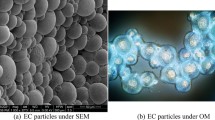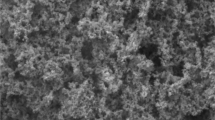Abstract
Brittle fracture of cement sheath, induced by perforation and stimulation treatments, can cause cross flow of formation fluid and increase casing damage. A novel agent XL was developed for solving the problem. Experimental results showed that the toughness of the set cement containing XL was improved remarkably. The engineering properties of the slurry containing XL, drag reducer USZ (0.2% BWOC), filtrate loss additive F17B (1.2% BWOC) and crystalloid expanding agent F17A (3% BWOC) could meet technical requirements of cementing operation. After perforation, good quality cement sheath enhanced with XL was observed by CBL/VDL logs in a deep well.
Similar content being viewed by others
References
API Recommended Practice 10B Specification for Materials and Testing for Well Cements (22nd Edition), December 1997
Brothers L. E. (2005) Cement compositions with improved mechanical properties and methods of cementing in subterranean formations.US Patent, 6962201
Dean G. D. and Torres R. S. (2002) Novel cement system for improved zonal isolation in steam injection wells.SPE, 78995
Deng J. G., Wang K. P., Huang R. Z. and Chen M. (1994) Collapse resistance of oil well casing-cement mantle combination subjected to non-uniform loading by rock creep.Journal of Rock Mechanics and Engineering, 13(2), 160–171 (in Chinese)
DiLullo G. A. and Rae P. J. (2004) High temperature flexible cementing compositions and methods for using same.US Patent, 6729405
Fang J., Yue B. Q., Zhao H. W. and Song Y. F. (1997) Analysis of surface loading on casing and cement sheath under nonuniform geologic stress.Journal of the University of Petroleum, China (Edition of Natural Science), 21(1), 46–48 (in Chinese)
Gao D. Y., Zhu H. T. and Tang J. Y. (2005) Shear strength of steel fiber reinforced high-strength concrete.Journal of Chinese Ceramic Society, 33(1), 82–86 (in Chinese)
Gao J. M., Sun W. and Morino K. J. (1999) Mechanical properties of high-strength steel fiber-reinforced concrete.Cement and Concrete Composites, 21(4), 263–268
Gao X. S., Fang J. and Wang L. H. (1994) Calculation method for collapse of oil casing restrained by concrete.Journal of the University of Petroleum, China (Edition of Natural Science), 18(3), 53–57 (in Chinese)
Goodwin K. J. (1997) Oilwell/gaswell cement-sheath evaluation.SPE, 39290
Guo W. C. and Liu H. X. (2001) Influence of bond cement property on casing external collapse load.Natural Gas Industry, 21(4), 53–54 (in Chinese)
Li Z., Su X. J. and Fu B. (1999) Determination of dynamic fracture toughness for cement block.Mechanics and Practice, 21(1), 41–44 (in Chinese)
Mack D. J. and Dillenbeck R. L. (2002) Cement: How tough is tough enough? A laboratory and field study.SPE, 78712
Marar K., Özgür E. and Tahir C. (2001) Relationship between impact energy and compression toughness energy of high-strength fiber-reinforced concrete.Materials Letters 47(4), 297–304
Morris W., Criado M. A. and Robles J. (2003) Design of high toughness cement for effective long lasting well isolations.SPE, 81001
Shen R. X., Cui Q. and Li Q. H. (2004)New Type Fiber Reinforced Cement-based Composites. Beijing: Publishing House of Building Materials and Industry in China, 42 (in Chinese)
Song M., Yang F. X., Song S. L., Zou F. M., Yan X. Z. and Yang X. J. (2002) Influencing tendencies of cement sheath on casing retaining capacity.Oil Drilling and Production Technology, 24(4), 7–9 (in Chinese)
Wang W. B., Ma H. Z. and Wei Z. S. (2004) Laboratory study of impact resistance toughness slurry system.Drilling Fluid and Completion Fluid, 21(1), 36–39 (in Chinese)
Yao W., Li J. and Wu K. R. (2003) Mechanical properties of hybrid fiber-reinforced concrete at low fiber volume fraction.Cement and Concrete Research, 33(1), 27–30
Zhang F., Ding Q. J., Ling Q. (2005) Research on steel fiber reinforcement lightweight aggregate concrete for deck pavement of steel box bridge.Concrete, 193(11), 46–48 (in Chinese)
Zhao J. P. and Cui H. P. (2004) Model and elasticity analysis of collapse strength of casing-cement mantle.Chinese Journal of Rock Mechanics and Engineering, 23(14), 2467–2470 (in Chinese)
Zhao J., Gao D. Y. and Tang J. Y. (2003) An experimental study on the axial compressive strength of fiber reinforced high-strength concrete.Concrete, 170(12), 23–24 (in Chinese)
Author information
Authors and Affiliations
Additional information
Hua Sudong was born in 1981 and received his MS degree from Nanjing University of Technology in 2007. He now is studying for his PhD degree in Nanjing University of Technology with his research interests in the additives of oil-well cement. E-mail: huasudong@163.com
Rights and permissions
About this article
Cite this article
Sudong, H., Xiao, Y. Properties and application of oil-well cement enhanced with a novel composite toughening agent. Pet. Sci. 4, 52–59 (2007). https://doi.org/10.1007/BF03187442
Received:
Issue Date:
DOI: https://doi.org/10.1007/BF03187442




